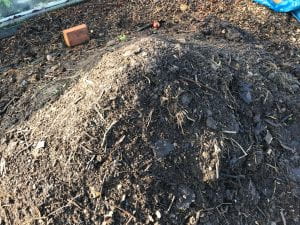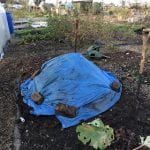18 day compost – December’s attempt
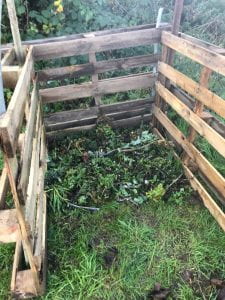 This post is part of my trial to build an 18 day compost heap each month of the year to see what happens – I wasn’t sure that it would work during the winter as the videos I had seen were made in Australia and other much hotter countries than the UK. You can see November’s results here.
This post is part of my trial to build an 18 day compost heap each month of the year to see what happens – I wasn’t sure that it would work during the winter as the videos I had seen were made in Australia and other much hotter countries than the UK. You can see November’s results here.
The issue in winter is gathering enough green material to make the heap big enough and I didn’t manage that last month. So, I am no longer making the heaps on the beds where I want to spread the compost but on a spare bit of land I was going to turn into another bed but haven’t done so yet. This gives me more space to turn the heap and to build bigger.
6th December 2020
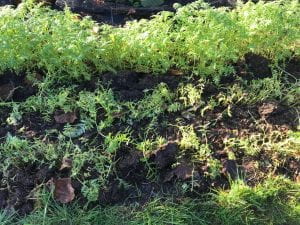 I can see why it is suggested that you have all your manure, brown and green materials and water at hand when you build the pile. I must have walked 10,000 steps getting everything in place as I built the heap; a lesson for January! I did mark out the size of the heap with pallets this time but realised after I had lugged them around that I could just use 4 poles pushed into the earth next time. Anyway, as I built the heap I also found that I didn’t have enough green material and so needed to cut down a bed of phacelia that I had sown at the beginning of October. I had originally planned for this to flower in the spring and then cut it down because it was sown on a bed that had had strawberries for about 5 years and the bed needs a serious bit of work on the soil. I also managed to find a few comfrey leaves to add to the pile to kick start the process and I wetted the materials a LOT more than last time.
I can see why it is suggested that you have all your manure, brown and green materials and water at hand when you build the pile. I must have walked 10,000 steps getting everything in place as I built the heap; a lesson for January! I did mark out the size of the heap with pallets this time but realised after I had lugged them around that I could just use 4 poles pushed into the earth next time. Anyway, as I built the heap I also found that I didn’t have enough green material and so needed to cut down a bed of phacelia that I had sown at the beginning of October. I had originally planned for this to flower in the spring and then cut it down because it was sown on a bed that had had strawberries for about 5 years and the bed needs a serious bit of work on the soil. I also managed to find a few comfrey leaves to add to the pile to kick start the process and I wetted the materials a LOT more than last time.
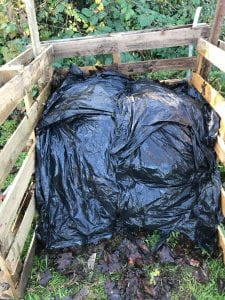 The pile is as big as I can make it and it is still not a cubic meter. The limiting factors at this time of the year are green materials and if I am to make a pile in January, I am going to have to go out on a scavenge. I spotted some younger nettles and weeds on the way into the plots yesterday so will harvest them over the next few days to start my January pile.
The pile is as big as I can make it and it is still not a cubic meter. The limiting factors at this time of the year are green materials and if I am to make a pile in January, I am going to have to go out on a scavenge. I spotted some younger nettles and weeds on the way into the plots yesterday so will harvest them over the next few days to start my January pile.
10th December 2020
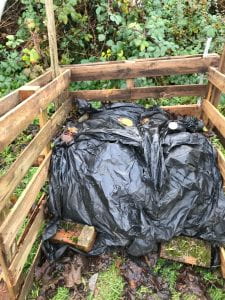

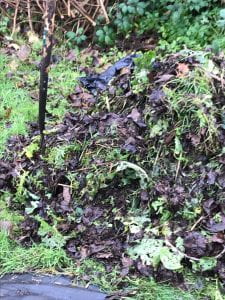

The heap had sunk quite a bit and was about 8.5°C which is no where near hot enough. Everything still looks the same and was damp enough so it was turned and covered for another two days.
12th December
I forgot to take my camera with me but really the compost didn’t look any different to the previous turn. What was different, however, was the temperature. The heap had reached a high of 12.5°C, an increase of 4°C. The next turn will probably need more water and I may add more green material and manure to see if I can get a greater heat. It will mean adding another 2 days to the making.
14th December
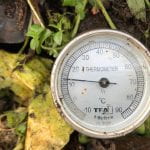
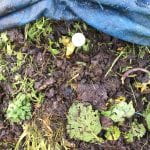

The temperature has gone up 0.5°C to 13°C so at this rate it will take me another 70 days to reach 50°C! The materials still look the same and I am now half way through the 6 turns. I have decided not to do anything to this pile but to just leave it. I know I need to add more green material and manure which means that thirds of green, brown and manure are not the right proportions for this climate at this time of year. Is it thirds by volume, which is what I do, or by weight? The manure is obviously heavier than the other two materials. I will experiment a bit with the January pile and add a LOT more green material. I am the mad, scavenging woman out around the town picking nettles and dandelion leaves so that I am ready! Oh, and there were two worms in the pile.
16th December
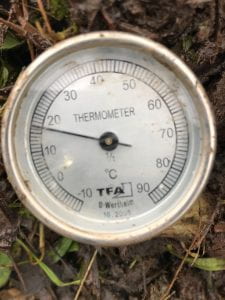
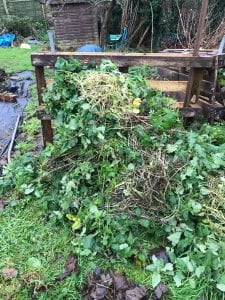
I think I might go as far as to say that the temperature is now up to 17°C, up 4°C on yesterday. It all still looks the same although a little more brown and I have removed the thick stalks and whole beetroot. Those were just wishful thinking!
I have been out and collected the nettles and weeds outside the allotment gates and there is quite a lot. If the January pile doesn’t get quite hot with all of these nettles, I don’t know what will.
19th December
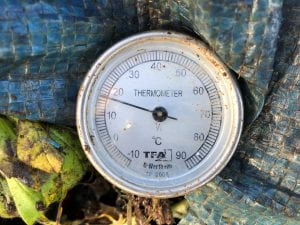 The weather was so bad on the 18th – 30mm of rain throughout the day – that I couldn’t/didn’t want to go down to the allotment so the turn of the pile was 1 day later. You can no longer identify the phacelia but the weeds which were not ripped up are still visible as is all the brown stuff although all are much more mixed up now. The pile is wet enough because the tarpaulin is woven and quite a bit of rain from yesterday go through.
The weather was so bad on the 18th – 30mm of rain throughout the day – that I couldn’t/didn’t want to go down to the allotment so the turn of the pile was 1 day later. You can no longer identify the phacelia but the weeds which were not ripped up are still visible as is all the brown stuff although all are much more mixed up now. The pile is wet enough because the tarpaulin is woven and quite a bit of rain from yesterday go through.
The temperature is down half a degree to 16.5°C so I am wondering if peak temperature has been reached or whether the lack of turning yesterday has slowed the process down. There were three worms in the pile. These are worms from the ground and they are only really in the lowest layer but every little helps!
21st December
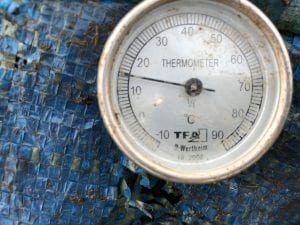
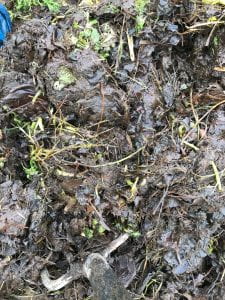
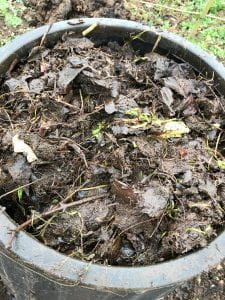
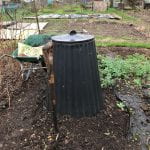
The temperature is going down now – 14.5°C today so unless I add some more green to the pile it will not get any hotter. For the final turn, I moved the heap to a dalek bin, or as we call them at home rat bins, that is on the bed where I want to use the resulting compost eventually. I will leave it in here a couple of months, still taking its temperature every week or so just to see what happens. The bin is full to the lid and the compost is quite wet – probably as wet as it should be because I could squeeze out a drop of water but it is wetter than I would normally allow compost to get. Maybe that will stop the rats taking up residence in it over the next month! It also smelt a bit which tends to suggest it is a bit anaerobic which is not helpful.
So, what am I going to do differently with January’s pile?
- Make it at least a cubic metre, all packed down. No airy-fairy trying to make it look like a cubic metre when it isn’t!
- Chop everything up quite small. This is not the sort of compost making that will rot down large roots, whole beetroot and Spanish radish. This needs premium materials in premium sizes which means I will need to take the leaves home and run them through the lawnmower to chop them up and add a little grass.
- If it doesn’t show signs of getting anywhere near the heat needed, I will add more green and manure and a couple of turns.
Happy Christmas to you all.
